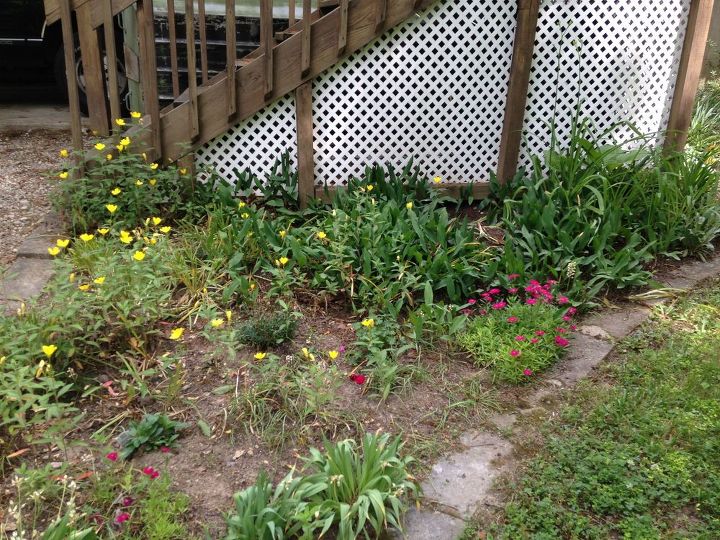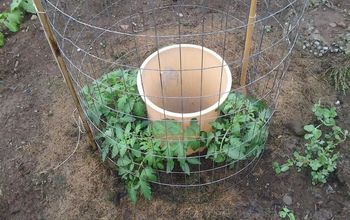How to improve clay soil?

I have several flower beds on property but the dirt is clay and it the lot is shady so plants do grow as well I would like. Deer and other animals also eat plants, too.
Related Discussions
GNATS - How to get rid of them?
Somehow my house and garden got tiny gnats that killed my fuchsia plant and fly everywhere. I have tried ALL the Web recommendations - soap and oil dishes, sand in th... See more
Marigolds growing! Should I pinch the buds?
My marigold plants are growing. I heard that pinching the buds until Autumn will allow them to grow without killing the plant. Is this true?
Growing garlic
Growing our first garlic, should we wait until the leaves are drying out before we pick it? Husband picked first one today along with our first potatoes.
How to keep mice out of your garden?
Hi everyone, I have mice in my garden destroying my vegetables and I have also noticed them in the barn and shed. Please can someone tell me how to prevent them from ... See more
What's the best flower/plant to grow in Texas?
I know that opinions vary, but what's your opinion?!I have great luck w Rosemary plants. Green all year long.




Hi Rhonda. I'm Cindy. Clay soil is rich in nutrients. But it can contain too much acidity or alkaline. The best way to improve either one is to use a lot of organic mulch. Organic mulch includes grass clippings, leaf and tree trimmings, and any other yard refuse. Work it into your soil over a long time. Just keep working it in. Six to eight inches of mulch should help considerably.
Hello, if you have room to start a compost pile this will help make great dirt for next year. Worm farm also makes great dirt and fertilizer. Or you can purchase several Large bags of Miracle grow for flowers, garden soil, and sterilized cow manure. I add 1 bag of miracle grow to 1 bag of garden soil, to 1/2 bag of sterilized cow manure. You can also add 1 cubic foot of peat moss to this mixture along with coffee grounds and crushed egg shells. Mix well.
Do not do either of the below methods during or right after rain as clay will clump together and not mix properly.
Method 1:
Dig up 1/2 wheel barrel of red clay and mix with above 1/2 wheel barrel full of above dirt mixture. Mix well. You can also add 1/2 lb. Epsom Salts to mixture if you are adding compost. After mixing dirt and clay together you return all of mixture to where you dug it up. Then remove next area of clay. Continue above method of mixing dirt until garden is complete.
Method 2:
If you prefer, you can break up clay soil you want to amend with good soil by taking a shovel and digging down about 1 1/2 feet into the clay soil. Make sure clay soil does not have large clumps in it. Next open all bags and empty them on top of clay area along with coffee grounds, egg shells and epsom salt. Make sure you distribute everything evenly. Then take a shovel or pitch fork and mix with your good soil into your clay soil. It is faster, however, it does require more muscle.
Happy soil amending! You will have beautiful happy and healthy plants in no time. Hint: I throw out coffee ground (and/or tea leaves) and crushed egg shells on top of my soil every day. I Distribute it evenly through my landscaped areas.
Rototill or dig in topsoil, peat moss, and compost into the clay.
I bring home coffee grounds from work and throw them on the soil to help with the clay.
I have also added bags of sand to keep clay from sticking together. First answer for you is excellent!
You can also buy a product called gypsum. Mend it into the soil. It will take some time but eventually really softens the soil.
The first step is to add gypsum to the soil. Apply gypsum at 1 kilo per square metre, digging this into the top 10-15cm well. Gypsum works on the clay, breaking it up into small crumbly pieces making it easier to work with and also improves drainage.
Gypsum is a source of calcium which is a major mechanism that binds soil organic matter to clay in soil which gives stability to soil aggregates. Gypsum complements or even magnifies the beneficial effects of water soluble polymers used as amendments to improve soil structure.
In colder seasons when your garden is taking a break, plant cover crops. These may include: Clover Timothy hay Hairy vetch Borage The roots will grow into the soil itself and act like a living soil amendment. Later, the whole plant can be worked into the soil to further add organic material.
You listed several situations: clay soil, shade, and browsing by animals. Each situation is a separate problem that have had entire books written about each.
Clay soil can be either acid or alkaline. The pH is due to the type of rock from which the soil weathered. Adding lime/gypsum may have worked for those people who are recommending it; however, not all clay soil is acidic. The black clay of central Texas is derived from limestone, chalk and limey marls, and other areas of the U.S. have limey soils. Do a soil test before you spend time and money adding amendments. At least talk with your local county extension agent about what soils are common to your location. You should be able to find one here: http://pickyourown.org/countyextensionagentoffices.htm
The one thing that will improve every soil is composted organic matter. Remove all the plants from any area that needs help. Add four to six inches of compost to the bed and turn it in with a spading fork or a rototiller. Afterward you can replant the area. Mulches are helpful in holding in moisture, but their real worth is to prevent rain compaction. Rain can hit with enough force to move soil particle three to five feet, and this also damages soil structure. Mulches do not need to be more than 2 inches thick and should not touch the base of a plant. In southern clay soils mulching up to a plant can lead to fungal diseases. Add more compost each year, digging it in where you can, or applying it like a mulch around perennials and bulbs.
If your yard is shady you should be using plants that like shade. Remember, though, that even shade loving plants prefer some sun. That is, woodland plants will grow and bloom better in dappled shade than in full shade. Conversely, in hot summer climates many sun lovers will do better with partial shade.
You can reduce the amount of shade by raising the crown which means removing the lowest branches only. This is easiest on upright and pyrimidal trees and difficult on those with a wide canopy. http://urbantree.org/raise5.shtml However, some very thickly branched trees may need crown thinning to allow more light through. http://urbantree.org/thinning1.shtml This is a much more complicated procedure that should be done by an arborist.
I have deer, and there are very few truly deer proof plants. When drought or some other situation curtails the food supply deer will eat plants they previously left alone. Furthermore, what is deer proof in one part of the country won't necessarily be deer proof somewhere else. The only sure way to prevent animal damage is a fence. Deer will not jump over a fence they can't see over, so a privacy fence will keep them out. Any fence that can be seen through needs to be at least 8 ft tall. Rabbits and other burrowing animals require a fence with narrow openings that can't be squeezed through that is also buried in the ground to prevent digging under. However, some animals such as raccoons and groundhogs are adept climbers and only caged gardens or gardens protected with electric fences will stay safe.
I have clay soil that during the summer is so hard I cannot dig a shovel into it. In the spring I have been adding bags of top soil and peat moss to my flower beds before I plant new flowers. They are getting better but it is a slow process.